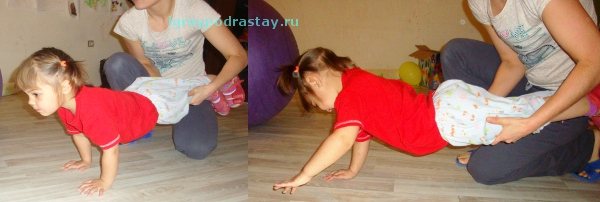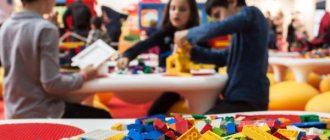Logic and mathematics - what to develop?
1. Learn the concept of “many - little”.
2. Closer to three years - master the concept of “more-less” (determine the number of objects in a group - which ones are more and which ones are smaller).
3. Learn to distinguish between the number of objects “one” and “two”. (At a minimum. You can go further, learn to count to 3 - 4, but not all children aged 2 to 3 can do this - take into account the child’s interest and his abilities).
4.Learn to sort objects - by size, by color, by type (sort different types of pasta, buttons, large and small objects (circles, squares, etc.)), try other types of sorting.
5. Learn to navigate in space (learn the concepts of higher, lower, right, left).
6. Fold yourself, without the help of your mother, elementary puzzles or cut-out pictures from 2-3-4 parts (this skill develops gradually and becomes more developed closer to three years; at first, the mother helps the child).
7. Learn to match - play “who eats what”, “where is whose house”, “where is whose tail” (with cards or in pictures in books and manuals).
8. Play riddles - the mother describes an object or animal in the simplest form, the child guesses it from the description (for example - small, fluffy, with long white ears, jumps like that and eats carrots, who is it? Who says “moo-moo” and gives milk? Etc. Gradually you can complicate the riddles).
9. Guess the animal from the description.
10. Stack several nesting dolls and cups into each other.
11. Build a tower from cubes/cups with decreasing size:
12. Learn to compare figures, geometric bodies with their projections (Dyenesha blocks, homemade preparations):
13. Closer to three years - designing simple structures according to the drawing (approximately like in the picture, but it’s better to start with two parts):
14. Starting from 2.5 years old, play Nikitin’s “Fold the Square” (at first, together with the child, but very quickly children learn to assemble it on their own):
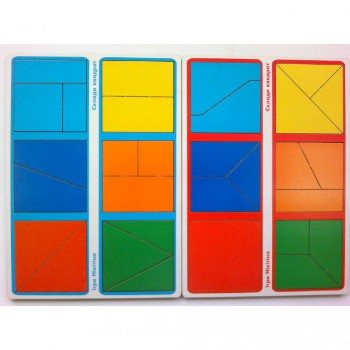
15. Starting from 2.5 years old - play prefabricated puzzles:
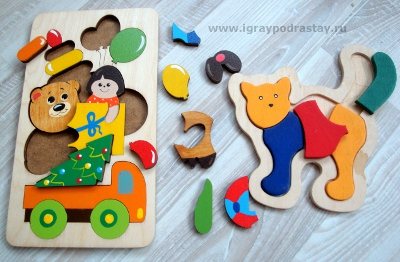
16. Learn to classify objects according to a general characteristic (for example: cards with images of toys, food, animals are laid out in front of the child. The child is asked to arrange them into appropriate groups (for example, toys in a box, food in a “refrigerator”, animals in a “house”). At first, the child learns to arrange objects with the active help of his mother.For the learning to be successful, it is better to play for a long time with the same set of objects (for example, to begin with, for a long time sorting cards of only toys and food).
Cards or wooden “Pick a Group” toys are great for mastering this skill:
17. Classification of objects - play the game “what’s in this room?” (find what is round in this room? What is soft in this room, etc.).
18. Games with Dienesh blocks, with a simple construction set, and other suitable items (toys, pasta, buttons, beads, etc.) by type:
- find objects, figures of the same shape;
- find objects, figures of the same color;
- find objects, figures of the same size;
- find the same figures by size, thickness and other characteristics.
19. Games with Cuisenaire sticks.
20. Play “part and whole” - “whose tail is this”, “match the roof to the house”, etc.
21. Learn to find a figure based on two signs (for example, find a large yellow circle (in a group of objects there is also a small yellow circle and circles of other colors), a small red square, etc.).
22. Closer to three years (and very individually) - find mistakes in pictures (working with manuals) - what is missing, what is wrong, which of the objects is the wrong color, etc. The very inexpensive manuals from the “Smart Books” series are great for this:
Advice from a psychologist to parents on raising a 2-3 year old child
Until the child reaches the age of 2–2.5 years, there is no point in punishing him. He does not yet feel like he is the culprit of the incident. He sees the result of his actions, but does not associate it with himself in any way, and does not realize how it happened. The only thing he will take away from punishment or reproach is that he is bad and is not loved.
Until a certain time, we must refrain from angry tirades and detailed explanations of what not to do. The baby still cannot understand them. At this stage, clear and reasonable restrictions and prohibitions are sufficient.
From about 2.5 years old, the child begins to feel like an independent person, and he is already able to understand who is to blame for the incident. He realizes that some actions are good and make loved ones happy, while others are bad. But he is still learning to control himself, and from time to time he will continue to act contrary.
Often at this age, children have imaginary friends to whom they shift responsibility for bad deeds. This allows the child not to feel guilty about the wrongdoing. It is important to understand the motives for his behavior. To do this, you need to discuss the incident with your child and help correct the situation. This must be done in a calm, friendly tone, then he will not be afraid of punishment and will willingly explain what motivated him.
At the age of three, children often behave badly, defining the boundaries of what is permitted and acting to spite their parents. This gives them a sense of adulthood and independence. If you punish for misdeeds, then instead of obedience the baby will show resistance. It is important to be patient at this stage; over time, the relationship with the baby will improve.
Hello, loving mothers and fathers. We are used to raising children in the same way we were raised. Did our parents know what is now available to us? I understood the nuances of the development of small children. What is the upbringing of a 2-3 year old child: psychology, expert advice for your attention. Want to figure it out? Then let's go!

Development of attention.
1. Play “Find it!” - we ask the child to find an object in the room (find where your teddy bear is, where the red cube is), on the street (look through the window - find where the dog is walking? Find the red car!), search in a picture in a book, etc. .P. – you can play anytime, anywhere. This game is very simple, children are easily drawn into it. At the same time, attention and the ability to concentrate it develop very well.
2. The game “Find a Pair” is a more complicated version than it was for a year or two - find a pair among objects that are very similar to each other. For example:
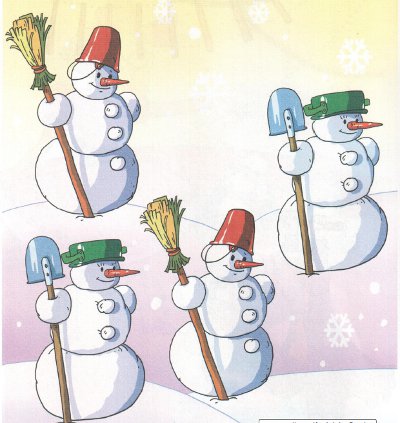
3. Find the same pattern (pairs of mittens, hats, cups and saucers, patches for towels, roofs for houses, etc.):
4. Closer to three years - build a turret, a house according to the drawing (you need to start with 2 parts).
5. Games with Dienesh blocks, Cuisenaire sticks.
6. Search for objects based on one characteristic - find what is red, hard, soft, round, large, etc. in this room. (you can play anywhere).
7. Search margin: 5px 0px; padding: 0px; line-height: 1.5em; text-align: justify; color: rgb(51, 51, 51); font-family: 'Helvetica Neue', Arial, Helvetica, sans-serif; font-size: 14px; background-color: rgb(255, 251, 250); objects based on two characteristics - find what is large and white, small and hard, etc. in this room.
8. Play hide and seek with the child (hide so that the baby can easily find it, prompt the child by calling him with your voice).
Difficulties in raising a child 2 - 3 years old
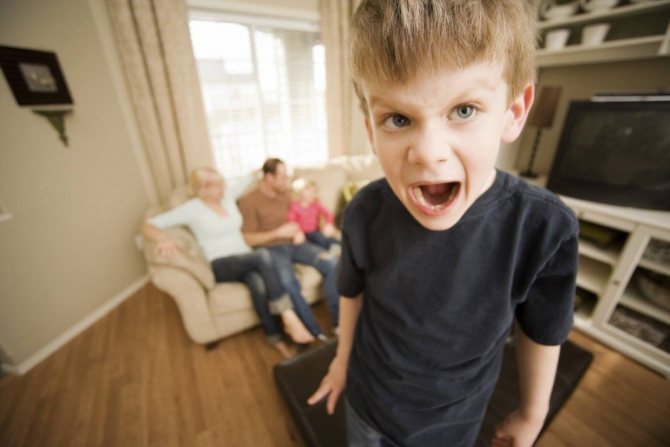
This period is characterized by the crisis of two years of age. There is a sudden change in behavior for the worse. The main feature of this crisis is hysterical behavior: screams, tears, stubbornness, unprecedented aggression.
From a psychological point of view, at this time you should be very careful about raising a child :
- react calmly, find compromises;
- during a hysteria, it is better to leave the baby alone in the room for a short time so that he calms down faster without an audience;
- explain the reasons for his actions if he objects to them;
- avoid places where the child may become overtired, hungry, or begin to be capricious;
- do not force them to give their toys to other children; at this age, the child does not understand why he should give his favorite things to others;
- Do not scold if the baby feels angry, it is better to hug him and calm him down.
How to develop memory.
1. “What’s missing?” - remember the pictures (toys) laid out on the table, guess which picture mom hid. Memorizing objects is carried out in a playful way - the mother tells a fairy tale about objects that are laid out on the table; during the process of the fairy tale, the child manages to remember its characters well. After this, mom takes one of them and asks “who is missing?” You can read more about how to play this game with very young children here.
2. What appeared? – we play according to the same principle as written in the previous paragraph, but we do not hide, but add toys, the child must determine which toy the mother added.
3. Hide 3-4 toys with the child. Then ask him to find them (we search from memory).
4. Ask the child to bring 2-3 items (we bring items from memory).
5. Together with the mother, remember what the child did yesterday, in the morning, some time ago, what events happened on the street (which friends were out today, what toys they had, etc.).
6. Remember what is drawn in the picture and answer questions about what was drawn there after the picture is closed.
7. Game “Find a Pair” with hide and seek – the mother shows the child a picture and hides it behind her back. Asks to find the same picture in a group of cards (the child looks for a paired picture not holding it in his hand, as usual, but from memory):
8. Game of “thimbles”. We take multi-colored cups and put a toy under one of them. We swap the cups several times, then ask them to find where the toy is hidden (we gradually increase the number of toys and cups).
9. “Memory” - a game with 2-3 cards. We put cards in front of the child, the child remembers them (to help him, you can tell a fairy tale about the heroes who are drawn in the pictures; while listening to the fairy tale, the child will remember the location of the cards well. The “fairy tale” can be very simple from 4-5 sentences). We turn the cards picture side down - this way, all the pictures are hidden from the baby and are not visible to him. We ask the child to find where a certain card is located from memory (“find which card has a bear on it?”). Another version of "Memory" can be found here.
Physical development.
1. Jump in place on two legs. Closer to three years - learn to jump forward (but not everyone succeeds in this).
2. Learn to throw and catch a ball, throw a ball against a wall.
3. Throw up a balloon or ball.
4. Maintain balance while walking along a board placed on the floor, along a bench, or a beam.
5. Depict animal movements as shown by mother.
6. Crawl (like a boa constrictor, like a caterpillar) on your stomach forward.
7. Jump like a bunny.
8. Pretend to be a bird - wave your arms while running around the room, squat - “look for grains in the grass”, jump - “fly up”.
9. Stomp loudly, raising your legs high, like an elephant.
10. Swim like an octopus: lie on your back, raise your arms and legs up, wave your arms and legs (“swim”).
11. Run fast, slow, on your toes.
12. Sitting on the floor, knock on the floor with your feet, “like a drum.”
13. Roll on the floor like a bun.
14. Jump from a half-squat like a frog.
15. Dance and practice logorhythmics (to the music of the Zheleznovs and other authors).
16. Lift objects from the floor by bending or squatting.
17. Reach your arms up, reaching for objects that are located high (the mother can hold objects at the height of the child’s outstretched arm).
18. Move around the room without touching objects scattered on the floor (for example, pillows), gradually increasing the pace and number of objects.
19. Carry large, but not heavy things (for example, a highchair, a light box of toys).
20. Walking on massage surfaces.
21. Walking on tiptoes, closer to three years - on heels.
22. Perform dance movements - place the foot on the toe, on the heel.
23. Walking along a winding line drawn on the floor (or a strip of paper) - development of coordination.
24. Crawling under a tight rope.
25. Game “Catch a sunny bunny” - we play with a sunny bunny that mom lets out.
26. Collective games: dance in a circle, run like a train after each other (children hold on to each other), games with a special children’s play parachute, games of “catch up”, “wolf and bunnies”, etc.
27. "Cat and mouse." While the cat is sleeping (an imaginary cat or another adult), the children and mother walk quietly. When the cat wakes up, they quickly run into the house.
28. Hanging on the horizontal bar, rings, mother’s hands.
29. Climb on sports walls at home, on playgrounds.
30. Walking on “bumps” (chaotically scattered pillows, books).
31. Climb through a tunnel (purchased or built from chairs placed in a row).
32. Fitball games.
33. Game “Snail and House”. The child gets on all fours. A pillow is placed on his back. He turns into a snail, which carries its house (pad) on its back. The snail's task is to go as far as possible without dropping its house (we crawl on all fours, carrying a pillow on our back).
34. Walking on your hands:
